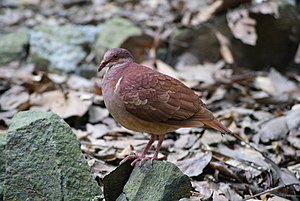Red earth dove
| Red earth dove | ||||||||||
|---|---|---|---|---|---|---|---|---|---|---|

Red earth dove |
||||||||||
| Systematics | ||||||||||
|
||||||||||
| Scientific name | ||||||||||
| Geotrygon montana | ||||||||||
| ( Linnaeus , 1758) |
The red earth dove ( Geotrygon montana ) is a species of pigeon birds. It occurs from Central to South America. It is classified as not endangered by the IUCN and is a common pigeon species in parts of its distribution area.
Appearance
The red earth dove can reach a body size of up to 28 centimeters depending on the subspecies. The shape is typically compact with a short tail. The head is brown, the front head very flat. Starting from the base of the beak, a pale yellow-brown stripe runs below the eye. A second stripe runs over the eye. The posterior neck, mantle, back and elytra are deep red-brown with a purple sheen. The chest, belly and under tail covers are lighter and more yellowish brown. The beak is reddish and darkens towards the tip. The iris is yellow to orange. The unfeathered dark circles are red. The feet are reddish. In males, the facial coloring is a little more intense. The females are darker on the upper side of the body and shimmer greener.
distribution and habitat
The red earth pigeon has a very large range that overlaps with that of most other species of American earth pigeons. The distribution area of the red earth dove extends from Mexico over Central America to Bolivia, Paraguay and the north of Argentina. Most of the Caribbean islands are also populated. However, it is missing in the Bahamas .
Their habitat are tropical primary and secondary forests. Their altitude distribution depends on the respective distribution area. It usually stays at an altitude of about 600 meters above sea level. In Colombia, however, it also inhabits moist subtropical forests up to 2,600 meters above sea level. The habitat must have dense undergrowth and sufficient dead leaves on the ground. However, it tolerates selective logging and also colonizes abandoned plantations on which dense undergrowth has formed. It is nomadic in parts of its range and has seasonal migrations. For this reason, the regional population density can fluctuate considerably.
behavior
The red earth pigeon is a relatively shy and inconspicuous species of pigeon, which is usually observed individually or in pairs. It is rarely exposed. It looks for its food among the dead leaves lying on the ground. Their food spectrum consists of seeds, small fruits, worms, insects and their larvae, as well as beetles and snails. The breeding time varies depending on their area of distribution. In Trinidad, for example, it breeds from February to July, in Peru and Bolivia from August to December.
During courtship, the male pursues the female in a tense posture. He spreads the under-tail coverts and the tail feathers to the side. Immediately before mating, the male jerks its head vertically upwards and quickly pulls it down again. Wing twitching or spreading and lifting of the wings are behavioral elements when the male shows the female suitable nesting places.
The nest is a loose platform made up of a few twigs and covered with small roots and dead leaves. It is found on dead tree stumps, on horizontal branches, between creepers or in the undergrowth and is usually erected one and a half meters above the ground. The clutch consists of one or two eggs. The breeding season lasts 10 to 11 days. The young birds fledge after 10 days. This is a very short reproductive time for a bird of this size. Both parent birds are involved in the rearing of the young birds.
Keeping in human care
Red earth pigeons were first shown at London Zoo in 1860 . They were introduced to Germany in large numbers in 1886. She is considered a very trusting pigeon with a peaceful behavior, which can be maintained very well in a social setting. However, since it is an inhabitant of tropical rainforests, it needs a lot of warmth and is dependent on a heated shelter in winter.
supporting documents
Individual evidence
- ↑ Rösler, p. 224
- ↑ Gibbs, p. 388
- ↑ Gibbs, p. 390
- ↑ Gibbs, p. 389
- ↑ Münst, p. 74
- ↑ Gibbs, p. 389
- ↑ Rösler, p. 225
literature
- David Gibbs, Eustace Barnes and John Cox: Pigeons and Doves - A Guide to the Pigeons and Doves of the World . Pica Press, Sussex 2001, ISBN 90-74345-26-3 .
- Alois Münst and Josef Wolters: Tauben - The species of wild pigeons , 2nd expanded and revised edition, Verlag Karin Wolters, Bottrop 1999, ISBN 3-9801504-9-6 .
- Gerhard Rösler: The wild pigeons of the earth - free living, keeping and breeding . M. & H. Schaper Verlag, Alfeld-Hannover 1996, ISBN 3-7944-0184-0 .
Web link
- Geotrygon montana inthe IUCN 2013 Red List of Threatened Species . Listed by: BirdLife International, 2012. Retrieved March 17, 2014.